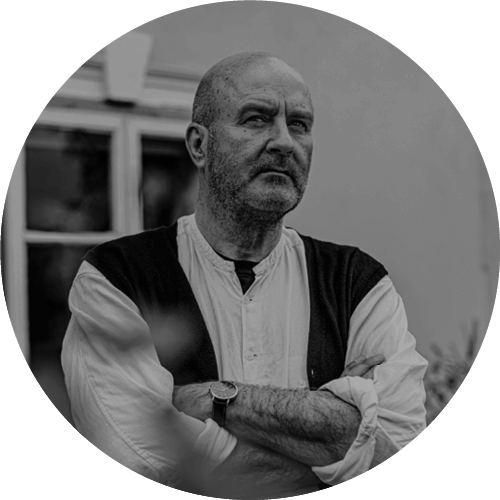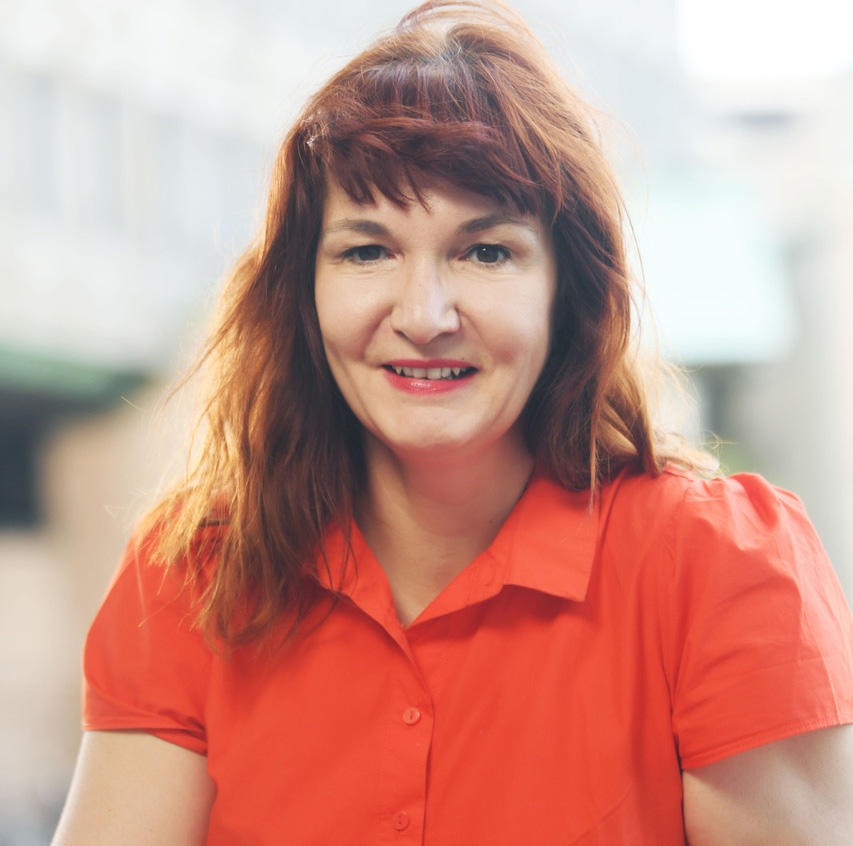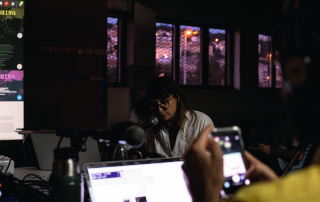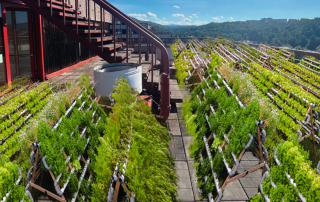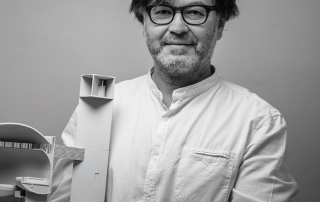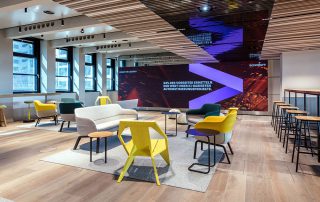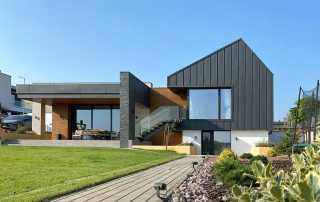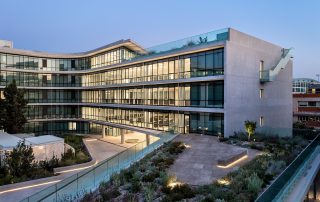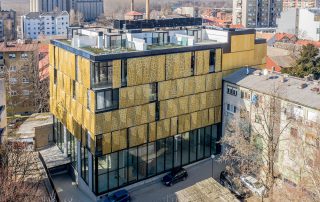Interview with Mika Cimolini
Mika Cimolini studied at the Faculty of Architecture in Ljubljana and the Berlage Institute in the Netherlands with research focusing on implementing product design and marketing strategies into architectural organisations. During her studies she worked as a journalist at RTV Slovenia for the Studio City programme and for the internationally renowned architectural office UN Studio in Amsterdam. Together with Igor Kebel, she co-founded Elastik, which was part of the internationally acclaimed travelling exhibition of contemporary Slovenian architecture called 6IX:PACK. At the same time, she co-founded Hikikomori with Aron Boršo and Aljoša Rot, which focuses on combining architecture with multimedia. She was the Head of Programme Management of the Centre for Creativity, the first national interdisciplinary platform for the development of the creative industries in Slovenia, which operates within the Museum of Architecture and Design in Ljubljana. She has been active within the Chamber of Architecture and Spatial Planning of Slovenia (ZAPS) for many years, and presently as the Commissioner for Communications and Events.


Harmonika house, Dolšce, Slovenia, 2017. Photo: © Miran Kambič
Your work in architecture is continuously changing, from Elastik to multimedia, from teaching to politics. What would you say is your main focus?
My main focus has been on conceiving ar- chitecture as an industrial product. Over the years, particularly during my collaboration with Igor Kebel on Elastik, we’ve developed methods integral to our project workflow, placing a strong emphasis on user-centric design. The nuances of everyday life have consistently been at the forefront of my at- tention, with a perpetual interest in exploring the dynamic interplay between private and public spaces and the evolving boundaries therein. The method that we have developed and named critical geometry meticulously con- siders various factors, including location constraints, limitations of the locations, and the materiality of con-structural elements. This comprehensive approach ensures a nuanced understanding of the intricate dy- namics shaping architectural design. Con- tinually intrigued by the fusion of industrial methodologies and architectural concepts, I aspire to bridge the gap between these 219 realms. The goal is not only to enhance ef- ficiency in the design process but also to contribute to the evolution of architecture by navigating the shifting landscape between public and private domains.
How has your time as a journalist at the Slovenian national television broadcast- er influenced your career?
My foray into the world of Slovenian national television began in the 1990s while I was still a student. This period provided ample op- portunities for me to shape my perspectives and develop certain opinions. Interestingly, my focus at that time extended beyond architecture to encompass intermedia and body arts. My work there thus became a platform for delving into the margins of the arts, exploring radical social phenomena amidst a backdrop of political change. The longevity of the Studio City show, span- ning 30 years until its cancellation in 2022, held immense significance for me. It served as a crucial platform for affirming my views on various subjects. I devoted my entire, six- year journalistic career to this show, starting at the age of 21. Studio City not only granted me the space to explore diverse realms, but also facilitated the development of my opinions over the years.
Why did you decide to leave Slovenian national television?
While pursuing my studies in the Nether- lands, I came to the realization that my true interest lay in the materiality of things. Ex- ploring how materials could be employed to initiate radical positions intrigued me. This perspective was a focal point of discussions during my time at the Berlage Institute with Pier Vittorio Aureli, today a prominent thinker and theorist in architecture, but in those days my fellow student. While Aureli advo- cated for architecture as an autonomous discipline, we were more inclined towards an inter-disciplinary approach. Throughout my academic journey, I remained focused on the user – examining how people engage with spaces, exploring adaptability in spatial usage, and seeking ways to enhance flexibility. I was particularly intrigued by the hybrid nature of architecture and the temporal aspects of space utilization. Questions such as how we use space at different times and the potential for sharing it became central to my architectural inquiries. This shift in focus ultimately led me to transition away from television, storytelling and observing social phenomena.

Mika Cimolini appearing on Studio City and talking about Plečnik on Slovenian national television in the 1990s. Photo: screen capture, archive of the Slovenian national broadcaster, RTV Slovenija

Mika’s text in the Slovenian ab magazine, 175/176 (2007) Packaging Architecture: Plečnik VS. Herzog De Meuron. Cover: ab magazine archive.
What’s your view of Jože Plečnik?
In the 1990s we grappled with the question of Slovenian national identity, and Plečnik became entwined in that discourse, albeit often misused. Fast forward thirty years, and the trend of appropriation and commodifica- tion has only intensified. Now, there’s even a brand of tea bearing Plečnik’s name, despite having no connection to him what- soever. I strongly oppose such appropria- tions, as they divert attention away from his substantial body of work.
You have been working at the Museum of Architecture and Design (MAO) in Lju- bljana. What do you think is the future of such a museum?
My role at MAO involved leading the pro- gram at the Centre of Creativity, the first national platform dedicated to fostering creative industries in Slovenia. While the mu- seum primarily works with the architectural and design heritage of Slovenia, our focus at the Centre of Creativity was forward- looking. We concentrated on initiatives to guide the creative sector towards a more business-oriented approach. This embraced the concept of a hybrid museum, which, in my view, represents the future of museums. Such an approach entails operating at the intersection of the past and future, allowing a museum to simultaneously engage with historical legacies and contribute to shaping the evolving landscape ahead.
I believe museums should consider their prospective visitors for the future. While museums function as research institutions, they shouldn’t confine themselves solely to academia. There’s a need to communicate the narratives of the past and the future to a wider audience. A noteworthy experience during my tenure at the Centre of Creativ- ity was a lecture by the car designer Rob- ert Lešnik. The lecture hall was filled to capacity, predominantly with men in their late thirties who may not have previously considered visiting a museum. This is how I envision the development of the museum’s audience.
What about your work in the Chamber of Architecture and Spatial Planning of Slo- venia, were you were involved in some commissions at the Ministry of Culture?
I was never in the position to create policies but I was very often in the position to offer advice. Since becoming a member of the Chamber of Architecture and Spatial Plan- ning of Slovenia in 2009, I’ve been actively involved in restructuring the chamber to enhance its proximity to members. Initiatives emphasising the need to make local municipal governments aware that disregarding 221 spatial planning rules can lead to problems when natural disasters occur. Neglecting ur- ban planning as a discipline tends to result in persistent problems and important issues that go unaddressed, with poorly executed architecture proving to be problematic and unsustainable in the long run.

The 6IX:PACK traveling exhibition of contemporary Slovenian architecture.
What was your experience practicing ar- chitecture in the Netherlands?
I haven’t been actively practicing in the Netherlands for the past few years, so I can’t offer any recent insights. However, I’ve heard that there has been a shift towards conservatism in terms of architectural pro- duction. A notable setback was the cancel- lation of the Netherlands Architecture Insti- tute, resulting in a decrease in architectural discourse and public debate. Institutions like these play a crucial role by consistently ad- dressing important themes and fostering an environment for debates in which architec- ture takes centre stage.
Could you elaborate on the 6IX:PACK phenomenon?
6IX:PACK was comprised of six – then young – Slovenian architectural firms (Bevk Perović arhitekti , Sadar+Vuga, Dekleva Gregorič arhitekti, Elastik: Kebel Cimolini, Mächtig Vrhunc Arhitekti and OFIS arhtiekti: Oman Videčnik), each of which had pursued studies abroad with the shared goal of en- hancing their skills and bringing newfound knowledge back to Slovenia. In the 1990s, there was a unique opportunity for young offices to thrive in Slovenia, given the vast empty space in the architectural landscape and the feasibility of winning competitions. However, when I curated the exhibition New Praxis, New Tools featuring ten of to- day’s young Slovenian practices, it became evident that the dynamics have shifted. Con- temporary practices now find themselves relying more on private clients and facing heightened competition for substantial pro- jects. The architectural vacuum that once existed in the 1990s has been filled.
During the era of 6IX:PACK, we were con- sidered exotic curiosities as awareness of contemporary architecture from the East was limited. We engaged in discussions about political change and explored how architecture could shape the identity of the emerging country, Slovenia. Today’s architectural firms no longer enjoy the same unique position. They address similar themes to their Western counterparts and have lost some of the exotic allure. The
such as awards given to the best realised work, fostering a more democratic and in- ternational approach. We were actively con- tributing to the implementation of architec- tural planning processes into laws – to bring them closer to the way we practice. We’ve seen success in these endeavours, and I am committed to furthering this work by advocating for an open and policy-oriented chamber, aiming to improve the position of architecture in society
Do these ideas come from your ex- perience of living and working in the Netherlands?
Yes, I believe they do. In the Netherlands architecture plays a significant role in shap- ing the national identity, and their modernity is deeply intertwined with architectural and
urban planning achievements. While there may be some ongoing struggles, particularly due to conservatism in architectural produc- tion, urban planning remains a central focus of public discourse in the country.
How about in Slovenia?
Following last year’s natural disasters and floods, there has been a heightened recog- nition of the importance of urban planning in Slovenia. The focus has shifted towards understanding the significance of urban planning. However, challenges arise when it comes to municipalities and the practical execution of urban planning. The influence of local politics often supersedes recom- mendations from urban planners, posing significant obstacles. This issue is a key concern for the Chamber of Architecture field in Slovenia has become somewhat formulaic, with only a few standout projects emerging from the prevailing, rather average architecture that has become the norm. Cli- ents, too, increasingly favour these norms, making it challenging to pursue more radical and innovative architectural endeavours.

Publication of the Women in Architecture project in Slovenia in ab magazine. Cover: ab magazine archive.

ATAR installation with David Tavčar
Is this influenced by the education of- fered at the Faculty of Architecture in Ljubljana?
I don’t believe so, as our education back then was even more challenging. In Slo- venia, the situation is now becoming more like what I experienced in the Netherlands, where individuals typically start working in architectural offices immediately after gradu- ation, around the age of 25. This early entry into professional life often limits the opportu- nities for exploration. By the time one reach- es the age of 50, they might be considered relatively old, possibly even retired, and only then might they have the freedom to engage in more experimental pursuits. And by then perhaps it’s too late.
Are you actively involved in promot- ing the work of women in architecture through the Chamber of Architecture and Spatial Planning of Slovenia?
My engagement in projects related to wom- en in architecture began after a significant travelling exhibition we organised in col- laboration with our Austrian counterparts in 2017. Their initiative aimed to showcase the contributions of female architects and bring attention to the significant presence of wom- en in the profession. What we discovered during that initiative was that nearly half of the practicing architects, who are members of the Chamber of Architecture of Slovenia, are female. This is a substantial figure, sig- nificantly larger than in Western countries. In the West there’s often a trend where women leave the profession after having children, either stopping work altogether or opting for occasional part-time roles. Conversely, in Eastern countries, such as Slovenia, women tend to balance family and profession simultaneously. It’s a tradition that harkens back to our mothers’ experi- ences in Yugoslavia, where being a female engineer or architect was not an anomaly but a natural part of professional life. Our research, conducted as part of a Euro- pean Union research project called Yes We Plan, focused on women in the architecture and engineering professions, and revealed some significant disparities. Few female architects receive national awards for their work, and there’s a notable absence of women in crucial leadership positions. De- spite their competence, female architects tend to be overshadowed. During my can- didacy for the presidency of the Chamber, where I came close to securing the position, I observed that even though young female architects supported me, there persists a perception that architecture is a male- dominated profession. This is significant, as female architects often bring unique perspectives to the table, considering top- ics that are frequently overlooked, such as adapting spaces for the elderly, moth- ers, and children. The inclination of female architects toward community and societal considerations surpasses that of their male counterparts. So it’s crucial for young girls to recognise that they can pursue any career, and have female role models in architecture. Breaking down stereotypes is essential for fostering diversity and ensuring that female architects receive the acknowledgment and opportunities they deserve.
How do you see architecture in the future?
I think that we’ll certainly witness an in- crease in renovations and decrease in new construction, as the spaces available for building are becoming more limited. The emphasis will shift towards responsible building practices, considering the location and environmental impact. The interplay between private and public spaces will gain prominence, particularly as media intrusion blurs the lines between them. Simultane- ously, there’ll be a rise in public life occur- ring within private spaces, exemplified by settings like shopping malls. However, there is a concern about avoiding a scenario akin to that seen in the US, where a lack of public spaces in cities is evident. I anticipate a more controlled approach to public spaces in the future, with a heightened awareness of their significance and purpose. The chal- lenge lies in striking a balance that respects both environmental sustainability and the evolving dynamics between public and pri- vate domains. I perceive a somewhat bleak scenario concerning public spaces, as the concept of “publicness” itself seems destined for an unfortunate transformation, moving to virtual spaces, to social media and so on. In a recent text of mine, “The Fight for the Public Space”, I explore how the physical manifestation of publicness in our squares has become nearly impossible due to the disappearance of public discourse.
Written by: Aleksander Ostan
An architect and urban planner, teaches at Ljubljana’s Faculty of Architecture. He co-runs Atelje Ostan Pavlin, focusing on sustainable, holistic design. Ostan is active internationally, conducts workshops, lectures, and writes, with numerous awards. More
Text: Boštjan Bugarič
Photos: Mateja Jordovič Potočnik, Miran Kambič, ab magazine Archive
